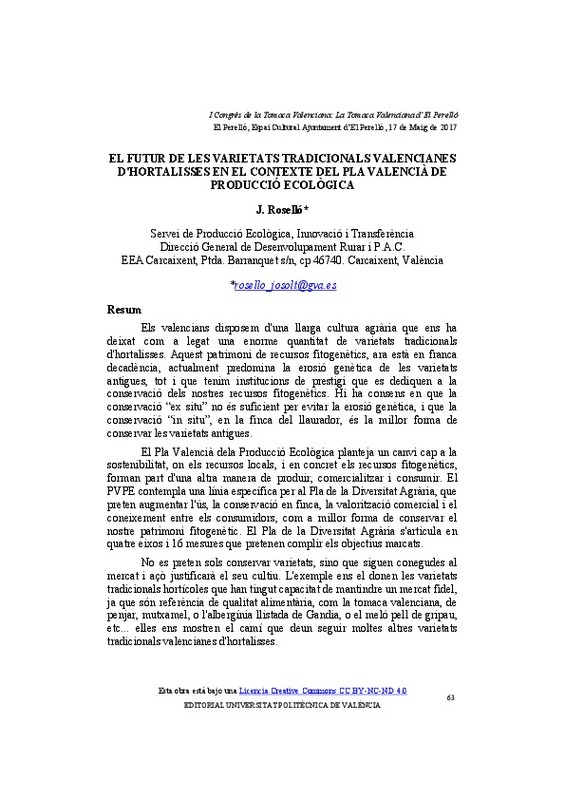|
Resumen:
|
[CA] Els valencians disposem d'una llarga cultura agrària que ens ha deixat com a legat una enorme quantitat de varietats tradicionals d'hortalisses. Aquest patrimoni de recursos fitogenètics, ara està en franca decadència, ...[+]
[CA] Els valencians disposem d'una llarga cultura agrària que ens ha deixat com a legat una enorme quantitat de varietats tradicionals d'hortalisses. Aquest patrimoni de recursos fitogenètics, ara està en franca decadència, actualment predomina la erosió genètica de les varietats antigues, tot i que tenim institucions de prestigi que es dediquen a la conservació dels nostres recursos fitogenètics. Hi ha consens en que la conservació “ex situ” no és suficient per evitar la erosió genètica, i que la conservació “in situ”, en la finca del llaurador, és la millor forma de conservar les varietats antigues. El Pla Valencià dela Producció Ecològica planteja un canvi cap a la sostenibilitat, on els recursos locals, i en concret els recursos fitogenètics, forman part d'una altra manera de produir, comercialitzar i consumir. El PVPE contempla una línia específica per al Pla de la Diversitat Agrària, que preten augmentar l'ús, la conservació en finca, la valorització comercial i el coneixement entre els consumidors, com a millor forma de conservar el nostre patrimoni fitogenètic. El Pla de la Diversitat Agrària s'articula en quatre eixos i 16 mesures que pretenen complir els objectius marcats. No es preten sols conservar varietats, sino que siguen conegudes al mercat i açò justificarà el seu cultiu. L'exemple ens el donen les varietats tradicionals hortícoles que han tingut capacitat de mantindre un mercat fidel, ja que són referència de qualitat alimentària, com la tomaca valenciana, de penjar, mutxamel, o l'albergínia llistada de Gandia, o el meló pell de gripau, etc... elles ens mostren el camí que deun seguir moltes altres varietats tradicionals valencianes d'hortalisses.
[-]
[EN] We the Valencians have a long agricultural culture that has left us an
enormous quantity of traditional vegetable varieties as a legacy. This
heritage of plant genètic resources is now in steep decline, and at present ...[+]
[EN] We the Valencians have a long agricultural culture that has left us an
enormous quantity of traditional vegetable varieties as a legacy. This
heritage of plant genètic resources is now in steep decline, and at present the
genètic erosion of old varieties prevails, even though we have prestigious
institutions that are devoted to the conservation of our plant genetic
resources. There is agreement that the “ex situ” conservation is not enough
to avoid genètic erosion, and that “in situ” conservation, in the farmers’
fields, is the best way to conserve old varieties.
The Valencian Plan of Organic Production suggests a change to
sustainability, where local resources, and in particular plant genètic
resources are part of another way of producing, marketing and consuming.
El VPOP has a specific line for the Plan of Agricultural Diversity, that aims
to increase the use, the conservation in farm, the commercial enhancement
and the knowledge among consumers, as the best way to conserve our plant
genètic heritage. The Plan of Agricultural Diversity is structured in four axis
and 16 measures that are aimed at meeting the objectives.
It is not only aimed at conservin varieties, but also to having them
known in the markets which justifies their cultivation. The example is given
by vegetable traditional varieties that have had the ability to maintain a
faithful market, as they are a reference of food quality, as the Valencian
tomato, de penjar, mutxamel, or the llistada de Gandia eggplant, or the toad
skin melon, etc... they show us the way that have to be followed by many
other Valencian traditional varieties of vegetables.
[-]
|






